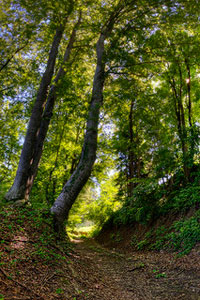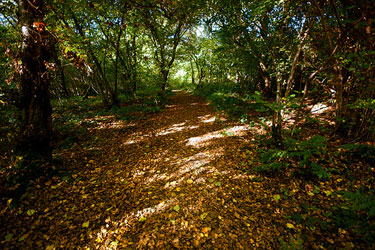
Source: A day at the beach, Jim Nix, Flickr
At the Sea-Side
When I was down beside the sea
A wooden spade they gave to me
To dig the sandy shore.
My holes were empty like a cup,
In every hole the sea came up
Till it could come no more.
This poem is really quite easy to understand. The speaker is a child playing in the sand on the beach. He digs a hole with a small shovel, and the sea washes into the holes and fills them. The poet does not convey a deep message; the poet merely describes a child’s experience.
As we mature, however, our tastes become more complicated, and we are capable of much deeper thought than when we were children. Now, we are given poems to read like “The Road Not Taken” by Robert Frost, which appears below.

Source: Path in the woods .:: HDR ::.,
Boris Mitendorfer Photography
Two roads diverged in a yellow wood,
And sorry I could not travel both
And be one traveler, long I stood
And looked down one as far as I could
To where it bent in the undergrowth;
Then took the other, as just as fair,
And having perhaps the better claim,
Because it was grassy and wanted wear;
Though as for that the passing there
Had worn them really about the same,
And both that morning equally lay
In leaves no step had trodden black.
Oh, I kept the first for another day!
Yet knowing how way leads on to way,
I doubted if I should ever come back.
I shall be telling this with a sigh
Somewhere ages and ages hence:
Two roads diverged in a wood, and I—
I took the one less traveled by,
And that has made all the difference.
This poem is more complicated. When Frost presents the two roads from which the speaker must choose one to travel, he is really speaking figuratively. Frost uses the roads as a metaphor for the paths we choose in life. Just as the speaker has to make a choice about which road to travel, we all must make decisions.
Frost also uses imagery to help us “see” the paths. One is “bent in the undergrowth,” while the other is “grassy and wanted wear.”
One way to help us understand a poem is to paraphrase it, or put it in our own words. For example, if you were to paraphrase the first eight lines, you might write something like this:

Source: Walk in the sun beams, lovestruck, Flickr
I saw two roads in front of me. I wanted to travel down both, but I had to make a choice. I looked down one road as far as I could see and followed the path with my eye. Then, I chose the other path. It looked like no one had been on it because it was covered in grass.
As you work through this lesson, you will learn how to interpret poetry. You will learn how to spot a metaphor, you will learn to identify imagery, and you will be introduced to the terms allusion and symbolism. When you come to the end of the lesson, you should find that poetry is not so difficult to understand after all.